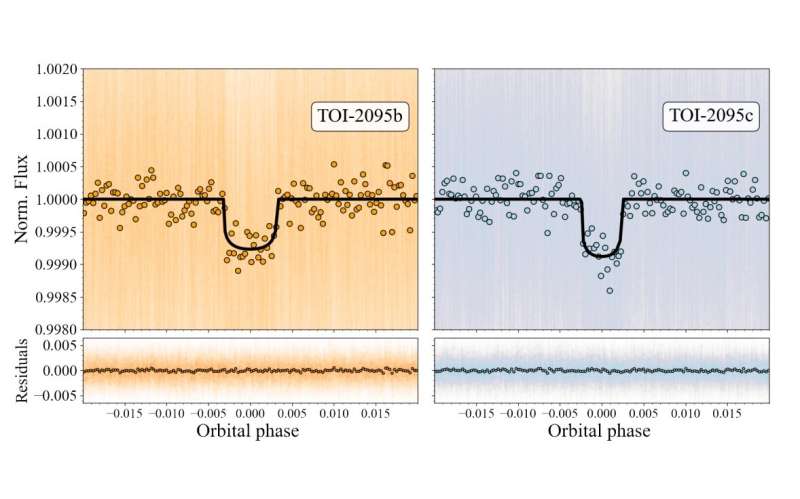May 1, 2023 report
This article has been reviewed according to Science X's editorial process and policies. Editors have highlighted the following attributes while ensuring the content's credibility:
fact-checked
preprint
trusted source
proofread
Astronomers discover two super-Earths orbiting nearby star

Using NASA's Transiting Exoplanet Survey Satellite (TESS), an international team of astronomers has discovered two "super-Earth" exoplanets orbiting a nearby M-dwarf star known as TOI-2095. The newfound alien worlds have short orbital periods and are slightly larger than the Earth. The findings were presented April 18 on the arXiv pre-print server.
TESS is conducting a survey of about 200,000 of the brightest stars near the sun with the aim of searching for transiting exoplanets, ranging from small rocky worlds to gaseous giants. So far, it has identified 6,400 candidate exoplanets (TESS Objects of Interest, or TOI), of which 330 have been confirmed to date.
Now, a team of astronomers led by Felipe Murgas of the University of La Laguna, Spain, reported that two more candidate extrasolar planets monitored with TESS have been confirmed. By conducting photometric observations and radial velocity measurements, they found that transit signals in the light curve of TOI-2095 are of planetary nature.
"We report the validation of two transiting planets around the M dwarf TOI-2095 discovered by TESS. We use ground-based high-resolution imaging, TESS photometric data, and CARMENES radial velocities to discard false positive scenarios, measure the planetary radii, and place stringent upper limits on the masses of the transiting candidates," the researchers explained.
The exoplanet nearer to the star, approximately 0.1 AU from it, received designation TOI-2095 b. According to the study, the planet is about 25% larger than the Earth and has an orbital period of 17.66 days. The equilibrium temperature of TOI-2095 b was found to be 347 K, while its mass is estimated to be not greater than 4.1 Earth masses.
The second planet in the system, TOI-2095 c, has a radius of about 1.33 Earth radii and orbits its host every 28.17 days, at a distance of some 0.137 AU from it. TOI-2095 c has an equilibrium temperature of approximately 297 K and its maximum mass was calculated to be 7.4 Earth masses.
The parent star TOI-2095 is about 56% smaller and less massive than the sun. It has a spectral type M2.5 V, effective temperature of 3,759 K, and metallicity at a level of -0.24. The age of the star is estimated to be at least one billion years.
Summing up the results, the authors of the paper noted that the two newly discovered exoplanets are close to the inner edge of the habitable zone of TOI-2095 and that their parameters make them attractive targets for further follow-up observations.
"In particular, extremely precise radial velocity follow-up observations can help to improve the mass measurements (and hence the bulk densities) of the planets and provide some constraints for future prospects for atmospheric characterization," the researchers wrote.
More information: F. Murgas et al, Two super-Earths at the edge of the habitable zone of the nearby M dwarf TOI-2095, arXiv (2023). DOI: 10.48550/arxiv.2304.09220
Journal information: arXiv
© 2023 Science X Network





















